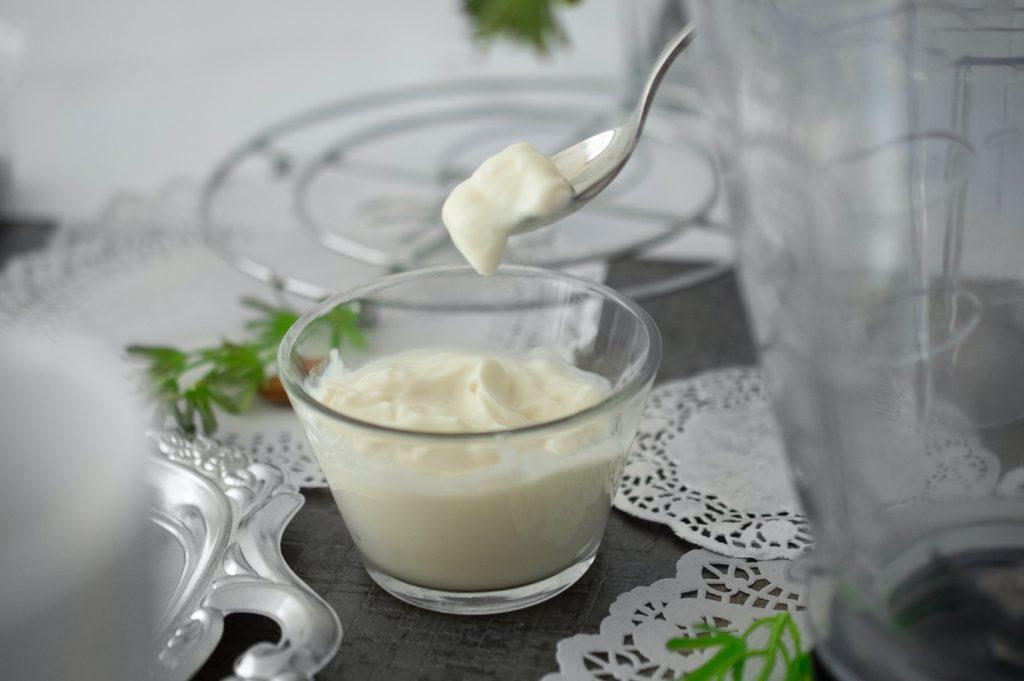
Mayonnaise is a very popular condiment, and perhaps the most versatile that we can find in the kitchen. You can use it on popular food items such as burgers, salads, French fries, and sandwiches. Furthermore, its unique composition makes it an ideal base for a lot of dips and sauces. But what exactly is mayonnaise?
Mayonnaise is a thick, creamy sauce made of emulsion of egg yolk, oil, and an acid, usually acetic acid or vinegar. In chemistry, an emulsion is a mixture of two liquids that are normally immiscible (like oil and water). But mayonnaise is a stable emulsion, hence does not separate under normal conditions. There are basically 2 types of emulsion: oil-in-water (O/W) and water-in-oil (W/O). Mayonnaise which typically contains 70% to 80% oil, is an example of the former. According to the Food and Drug Administration (FDA), mayonnaise should contain not less than 65 % by weight of vegetable oil. Commercial mayonnaise may contain more additional ingredients such as a stabilizer and flavor.
The reason why the components in mayonnaise do not separate, making it stable is because of the presence of egg yolk, an excellent emulsifier. Emulsifiers are ingredients or additives that hold several roles, and one of them is preventing immiscible liquids from separating. In the case of mayonnaise, the emulsifier is the egg yolk because its proteins are capable of protecting the oil droplets against coalescence.
Generally, emulsifiers are effective because they contain both a hydrophobic (oil-loving) molecular end and a hydrophilic (water-loving) end, making them a bridge between two immiscible liquids, forming an emulsion.
You might also like: Emulsifiers In Food: What Are They?
How Is It Made?
Mayonnaise is prepared by slowly pouring little amounts of oil at a time into the vinegar and egg yolk mixture and continuing to beat until the oil is broken up into droplets to form an emulsion.
The more oil is added, the more droplets form, increasing the surface area substantially. The continuous phase (acid) extends out and forms a thin film around the oil droplets. Because the droplets are packed firmly together and separated only by a thin film of aqueous phase, the mayonnaise thickens and may even become stiff enough to cut.
The fundamental idea behind cooking with an emulsion is to create small enough droplets or pieces of oil or water to be equally distributed throughout the mixture. Small droplets are made via sheering, a physical force that is most typically used with a food processor, blender, or a whisk. Fine-gauge strainers are used in industrial kitchens to force fluids to form an emulsion.
You might also like: Why You Should Not Use Pasteurized Egg (Whites)
In the home kitchen, making the emulsion is possible using a whisk. If whisked vigorously enough, the oil can be dispersed into 3 thousandths of a millimeter across. This is the same as a regular blender.
Some salad dressings resemble mayonnaise, but contain less oil and have a thinner consistency. The addition of stabilizers such as gums or starches generally improves the stability of the emulsion.
How Long Is Homemade/commercial Mayonnaise Good For?
The presence of acetic acid in vinegar or citric acid in lemon juice causes the proteins covering the emulsion droplets to interact, resulting in a gel-type emulsion. The acid also provides tartness in mayonnaise. Furthermore, it provides antimicrobial properties, preventing mayonnaise from going rancid and spoil.
The temperature at which mayonnaise is kept after preparation affects the texture and quality of the sauce. Mayonnaises and other cold emulsions can be stored in the refrigerator or at room temperature.
Like most food items, homemade mayonnaise spoils faster than its commercial counterpart. At most, it can last up to 7 days in the refrigerator. After this time, the risk of salmonella poisoning due to the egg yolk increases.
You might also like: Best Before Date Vs Expiry Date: How Do Manufacturers Figure These Out? – The Food Untold
Commercial mayonnaise is more commercial stability because it uses pasteurized egg yolk and preservatives. An unopened jar of mayonnaise can be stored in the pantry at room temperature. But the refrigerator is also a good option to preserve its quality. It should be kept refrigerated once opened. Doing so will maintain its best quality for up to 3 months after the best-by date indicated on the label. Food manufacturers select the best before date well in advance of the product’s probable spoilage. Foods with a shelf life of more than 90 days do not need a best before date on the label. So it is up to the manufacturer to include one.
Just make sure that the container is not damaged—check if the lid is not rusty, or there is any bulging— no signs of spoilage such as off-odor, color change or mold growth.


